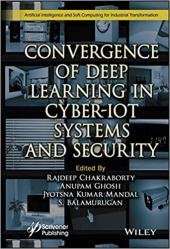Convergence of Deep Learning in Cyber-IoT Systems and Security
- Добавил: literator
- Дата: 7-11-2022, 05:39
- Комментариев: 0
 Название: Convergence of Deep Learning in Cyber-IoT Systems and Security
Название: Convergence of Deep Learning in Cyber-IoT Systems and SecurityАвтор: Rajdeep Chakraborty, Anupam Ghosh, Jyotsna Kumar Mandal
Издательство: Wiley-Scrivener
Серия: Artificial Intelligence and Soft Computing for Industrial Transformation
Год: 2023
Страниц: 472
Язык: английский
Формат: pdf (true)
Размер: 50.5 MB
In-depth analysis of Deep Learning-based cyber-IoT systems and security which will be the industry leader for the next ten years.
Deep Learning (also known as deep structured learning) is part of a broader family of Machine Learning methods based on artificial neural networks with representation learning. Learning can be supervised, semi- supervised or unsupervised. Deep Learning architectures such as deep neural networks, deep belief networks, deep reinforcement learning, recurrent neural networks and convolutional neural networks have been applied to fields including computer vision, speech recognition, natural language processing (NLP), machine translation, bioinformatics, drug design, medical image analysis, material inspection and board game programs, where they have produced results comparable to and in some cases surpassing human expert performance. Artificial neural networks (ANNs) were inspired by information processing and distributed communication nodes in biological systems. ANNs have various differences from biological brains.
Specifically, artificial neural networks tend to be static and symbolic, while the biological brain of most living organisms is dynamic (plastic) and analogue. The adjective “deep” in Deep Learning refers to the use of multiple layers in the network. Early work showed that a linear perceptron cannot be a universal classifier, but that a network with a nonpolynomial activation function with one hidden layer of unbounded width can. Deep learning is a modern variation which is concerned with an unbounded number of layers of bounded size, which permits practical application and optimized implementation, while retaining theoretical universality under mild conditions. In deep learning the layers are also permitted to be heterogeneous and to deviate widely from biologically informed connectionist models, for the sake of efficiency, trainability and understandability, whence the “structured” part.
Deep Learning approaches are now used in every aspect of cyber systems and IoT systems. The main goal of this book is to bring to the fore unconventional cryptographic methods to provide cyber security, including cyber-physical system security and IoT security through Deep Learning techniques and analytics with the study of all these systems.
This book provides innovative solutions and implementation of deep learning-based models in cyber-IoT systems, as well as the exposed security issues in these systems. The 20 chapters are organized into four parts. Part I gives the various approaches that have evolved from machine learning to deep learning. Part II presents many innovative solutions, algorithms, models, and implementations based on deep learning. Part III covers security and safety aspects with deep learning. Part IV details cyber-physical systems as well as a discussion on the security and threats in cyber-physical systems with probable solutions.
Audience:
Researchers and industry engineers in Computer Science, information technology, electronics and communication, cybersecurity and cryptography.
Скачать Convergence of Deep Learning in Cyber-IoT Systems and Security
Внимание
Уважаемый посетитель, Вы зашли на сайт как незарегистрированный пользователь.
Мы рекомендуем Вам зарегистрироваться либо войти на сайт под своим именем.
Уважаемый посетитель, Вы зашли на сайт как незарегистрированный пользователь.
Мы рекомендуем Вам зарегистрироваться либо войти на сайт под своим именем.
Информация
Посетители, находящиеся в группе Гости, не могут оставлять комментарии к данной публикации.
Посетители, находящиеся в группе Гости, не могут оставлять комментарии к данной публикации.
